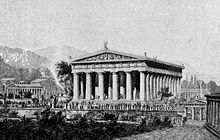Oracle of Olympia
The oracle of Olympia was an ancient oracle in Olympia dedicated to Zeus Olympios , the highest of the Olympian gods . It was located in a crevice at the foot of Kronos Hill . The oracle's seers were asked about questions of war, since Zeus was considered to be the ruler of wars.
history
The oracle is only mentioned in passing in ancient literature, only Pindar and Strabo mention it as an essential part of the cult in Olympia. In his Olympic Odes, Pindar describes the mythical origins of the first oracle priest Iamos and the establishment of the oracle on the ash altar of Zeus at the behest of Iamos' father Apollo . Strabon reports that the Olympia sanctuary originally owed its fame to the oracle and only later became famous through the Olympic Games .
Oracle service
The oracle service was carried out in Pindar by the Iamidai family , who were considered to be the Iamos' agreement. The descendants of Klytios , the Klytiadai , are attested by inscriptions as the seer family, so that Cicero could come to the assumption that both sexes would perform the oracle service together. Herodotus names the Telliadai as well as the Iamidai , while Flavius Philostratos assumes three sexes.
The only surviving report of an oracle service in Olympia itself comes from the early 4th century by Xenophon , who describes a questioning of the Spartan king Agesilaus . Agesilaos wanted to make sure whether he could refuse a truce offered by the Argives and received the answer that this was permissible. Before attacking his troops, he asked the Oracle of Delphi for security , where he got the same answer.
The reason for the rare mention in ancient literature is assumed to be the peculiarity of the oracle that the oracle service could be performed independently of the oracle site. The Olympic seers went with the generals onto the battlefield, where they determined the time of the attack or gave advice on tactical maneuvers. After the historically limited reliable reports of Herodotus the Olympic seers were almost present in the first half of the 1st millennium wherever Greeks beat a battle, saved as historically their presence the Athens applies among other things on the side in the Battle of Plataea 479 v. Or on the side of the Spartans in the battle of Aigospotamoi 405 BC Chr.
Consecration offerings

In the Zeus temple there were numerous votive offerings with inscriptions addressed to Zeus from the 8th to the 5th century. v. BC, which mostly consist of captured weapons and armor and were set up as Tropaia . In addition, statues of Zeus or Nike were donated as thanks for the successful course of the war , and the temple itself and the Zeus statue of Phidias inside it also came from the booty of a war that the Eleans are said to have waged against Pisa , according to the tourist guides that Pausanias followed . Pausanias also reports on numerous other foundations apart from the Temple of Zeus, including several statues from various poleis and structures such as the Philippeion donated by the Macedonians or the treasure houses on the northern edge of the Altis .
literature
- Ulrich Sinn : Olympia. The position of the competition in the cult of Zeus Olympios . In: Nikephoros 4, 1991, pp. 31-54.
- Ulrich Sinn: Ancient Olympia. Gods, games and art . CH Beck, Munich 2004, ISBN 3406515584 , pp. 59-61.
- Nigel Spivey : The Ancient Olympics . Oxford University Press, Oxford 2005, ISBN 0192806041 , pp.?.
Individual evidence
- ↑ Pindar Olympic Ode 6, 27-73.
- ^ Strabo 8, 3, 30.
- ↑ Cicero De divinatione 1, 41.
- ↑ Herodotus 9:38, 1.
- ↑ Flavius Philostratos Vita Apollonii 5, 25.
- ↑ Xenophon Hellenika 4, 7, 2.
- ↑ Ulrich Sinn: The ancient Olympia . Pp. 59-60.
- ↑ Ulrich Sinn: The ancient Olympia . Pp. 60-61.
- ↑ Holger Baitinger: Weapons and armament from the Persian booty in Olympia . In: Archäologischer Anzeiger 1999, pp. 125–139.
- ^ Pausanias 5:10 , 2.
